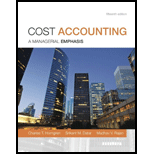
Cost Accounting: A Managerial Emphasis, 15th Edition
15th Edition
ISBN: 9780133803815
Author: Charles T. Horngren, Srikant M. Datar, Madhav V. Rajan
Publisher: PEARSON
expand_more
expand_more
format_list_bulleted
Question
Chapter 20, Problem 20.20E
1.
(a)
To determine
To compute: The EOQ.
(b)
To determine
To compute: To compute the annual relevant carrying cost.
2.
To determine
To explain: The impact of changes in ordering and carrying cost on EOQ and total relevant cost.
3.
To determine
To compute: The cost of prediction error.
Expert Solution & Answer
Want to see the full answer?
Check out a sample textbook solution
Students have asked these similar questions
On July 1, the accounts receivable account balance was $77,500. During July, $335,000 was collected from customers on account. Assuming the July 31 balance was $75,400, determine the fees billed to customers on account during July.
Can you solve this financial accounting problem using appropriate financial principles?
Please explain the solution to this general accounting problem with accurate principles.
Chapter 20 Solutions
Cost Accounting: A Managerial Emphasis, 15th Edition
Ch. 20 - Why do better decisions regarding the purchasing...Ch. 20 - Name six cost categories that are important in...Ch. 20 - What assumptions are made when using the simplest...Ch. 20 - Give examples of costs included in annual carrying...Ch. 20 - Give three examples of opportunity costs that...Ch. 20 - What are the steps in computing the cost of a...Ch. 20 - Why might goal-congruence issues arise when...Ch. 20 - JIT purchasing has many benefits but also some...Ch. 20 - What are three factors causing reductions in the...Ch. 20 - You should always choose the supplier who offers...
Ch. 20 - Prob. 20.11QCh. 20 - What are the main features of JIT production, and...Ch. 20 - Distinguish inventory-costing systems using...Ch. 20 - Describe three different versions of backflush...Ch. 20 - Discuss the differences between lean accounting...Ch. 20 - Prob. 20.16ECh. 20 - Prob. 20.17ECh. 20 - Prob. 20.18ECh. 20 - Prob. 20.19ECh. 20 - Prob. 20.20ECh. 20 - Prob. 20.21ECh. 20 - Prob. 20.22ECh. 20 - Prob. 20.23ECh. 20 - Prob. 20.24ECh. 20 - Prob. 20.25PCh. 20 - Prob. 20.26PCh. 20 - Prob. 20.27PCh. 20 - Prob. 20.28PCh. 20 - Prob. 20.29PCh. 20 - Supply-chain effects on total relevant inventory...Ch. 20 - Prob. 20.31PCh. 20 - Prob. 20.32PCh. 20 - Prob. 20.33PCh. 20 - Prob. 20.34PCh. 20 - Lean accounting. Reliable Security Devices (RSD)...Ch. 20 - Prob. 20.36P
Knowledge Booster
Similar questions
- The appropriate adjusting entry to be made at the end of the period would bearrow_forwardIvanhoe Company had these transactions during the current period. June 12 Issued 82,500 shares of $1 par value common stock for cash of $309,375. July 11 Issued 3,450 shares of $100 par value preferred stock for cash at $107 per share. Nov. 28 Purchased 2,650 shares of treasury stock for $13,250. Prepare the journal entries for the Ivanhoe Company transactions. (Record journal entries in the order presented in the problem. Credit account titles are automatically indented when amount is entered. Do not indent manually. List all debit entries before credit entries. If no entry is required, select "No Entry" for the account titles and enter O for the amount in the relevant debit OR credit box. Entering zero in ALL boxes will result in the question being marked incorrect.)arrow_forwardFinancial Accounting Questionarrow_forward
- Agree or disagree with this post Because it shows ownership held by several people or entities rather than just one, the Stockholders' Equity portion of a corporate balance sheet is very different from that of a single-owner company. The claims of shareholders on a corporation's assets are represented by its common stock, preferred stock, retained earnings, additional paid-in capital, and treasury stock (Warren et al., 2022). On the other hand, a single-owner company usually shows the owner's entire investment and cumulative profits in a single capital account under owner's equity. This distinction highlights the size and complexity of corporate ownership, as equity must take into consideration repurchases, stock issuances, and dividends—elements that are uncommon in sole proprietorships. Since corporations are legally distinct legal entities, there must be room for several stockholders with different rights and interests in their equity structure, particularly when stock classes…arrow_forwardI am trying to find the accurate solution to this financial accounting problem with the correct explanation.arrow_forwardI need assistance with this financial accounting question using appropriate principles.arrow_forward
arrow_back_ios
SEE MORE QUESTIONS
arrow_forward_ios
Recommended textbooks for you

 AccountingAccountingISBN:9781337272094Author:WARREN, Carl S., Reeve, James M., Duchac, Jonathan E.Publisher:Cengage Learning,
AccountingAccountingISBN:9781337272094Author:WARREN, Carl S., Reeve, James M., Duchac, Jonathan E.Publisher:Cengage Learning, Accounting Information SystemsAccountingISBN:9781337619202Author:Hall, James A.Publisher:Cengage Learning,
Accounting Information SystemsAccountingISBN:9781337619202Author:Hall, James A.Publisher:Cengage Learning, Horngren's Cost Accounting: A Managerial Emphasis...AccountingISBN:9780134475585Author:Srikant M. Datar, Madhav V. RajanPublisher:PEARSON
Horngren's Cost Accounting: A Managerial Emphasis...AccountingISBN:9780134475585Author:Srikant M. Datar, Madhav V. RajanPublisher:PEARSON Intermediate AccountingAccountingISBN:9781259722660Author:J. David Spiceland, Mark W. Nelson, Wayne M ThomasPublisher:McGraw-Hill Education
Intermediate AccountingAccountingISBN:9781259722660Author:J. David Spiceland, Mark W. Nelson, Wayne M ThomasPublisher:McGraw-Hill Education Financial and Managerial AccountingAccountingISBN:9781259726705Author:John J Wild, Ken W. Shaw, Barbara Chiappetta Fundamental Accounting PrinciplesPublisher:McGraw-Hill Education
Financial and Managerial AccountingAccountingISBN:9781259726705Author:John J Wild, Ken W. Shaw, Barbara Chiappetta Fundamental Accounting PrinciplesPublisher:McGraw-Hill Education


Accounting
Accounting
ISBN:9781337272094
Author:WARREN, Carl S., Reeve, James M., Duchac, Jonathan E.
Publisher:Cengage Learning,

Accounting Information Systems
Accounting
ISBN:9781337619202
Author:Hall, James A.
Publisher:Cengage Learning,

Horngren's Cost Accounting: A Managerial Emphasis...
Accounting
ISBN:9780134475585
Author:Srikant M. Datar, Madhav V. Rajan
Publisher:PEARSON

Intermediate Accounting
Accounting
ISBN:9781259722660
Author:J. David Spiceland, Mark W. Nelson, Wayne M Thomas
Publisher:McGraw-Hill Education

Financial and Managerial Accounting
Accounting
ISBN:9781259726705
Author:John J Wild, Ken W. Shaw, Barbara Chiappetta Fundamental Accounting Principles
Publisher:McGraw-Hill Education